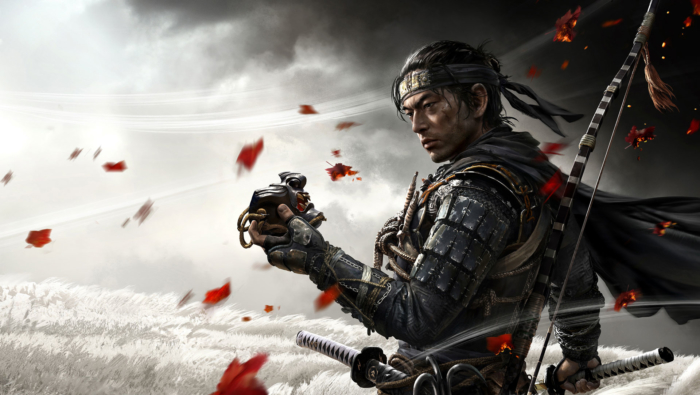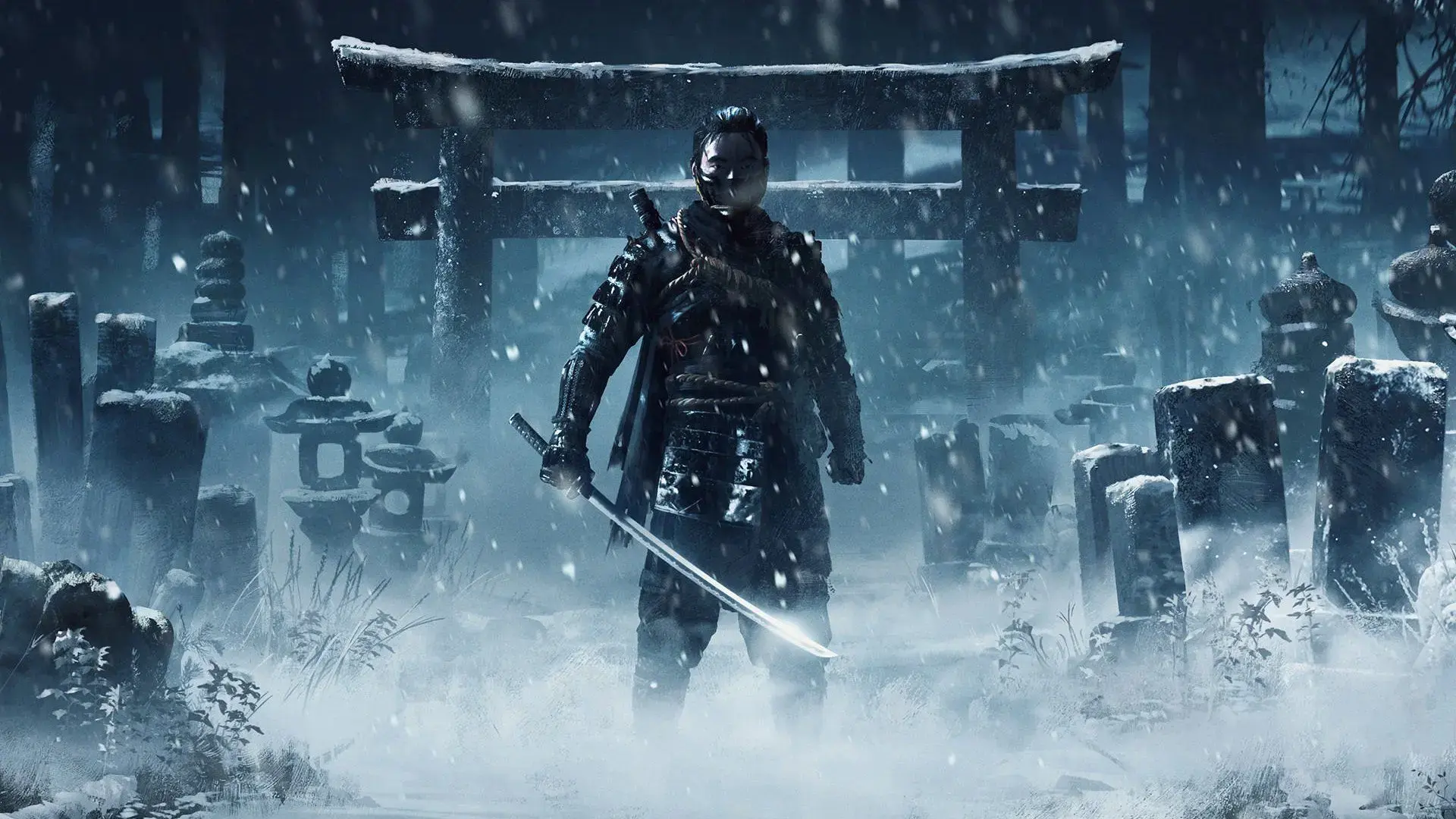Ghost of Tsushima–A Samurai Adventure on PS4
-
Gorgeous, vibrant visuals
-
Unique greyscale and difficulty features
-
More Samurai feature-film than epic open-world adventure
Set during the Mongol invasion during the 13th century, Ghost of Tsushima honours Japanese Samurai culture with a stunning, open-world action-adventure game.
Sucker Punch’s latest foray wasn’t meant to be a triple-A title but it was judged as one after its exclusive release on PS4 in 2020. Normally a PC gamer myself, I borrowed a friend’s PS4 to try this game out. I’m glad that I did. This is a game that renders the beauty of Japan’s nature perfectly. Bright blue flowers and swaying red maples frame your journey on horseback through contrasting grasslands. Dangerous Mongolian camps, glorious temples and cinematic viewpoints embellish the reasonably-sized map.
You’re given fair freedom to pursue the (perhaps too numerous) side quests and gather more weapons and kills. All the while the legend of your stoic character, Jin Sakai, spreads across the island.
The cinematography and storytelling surrounding your playable character mirrors Samurai Hollywood movies of the 60s and 70s. I frequently battled foes one-on-one in an epic, winner-takes-it-all fashion. This is a dramatic game all the way through its combat, plot progression, and boss battles.
To its detriment, I sometimes felt like the cinema drama was a stand-in for genuinely imaginative quests. There are some flat moments, and ‘chase the yellow bird’ feels like it should become a euphemism for distracting yourself when you’re bored. Endless distractions and side missions aside, Ghost of Tsushima stands up on its own as an enticing stealth game that easily gives Assassin’s Creed a run for its money with some clever mechanics to boot.
Follow the Birdie
Riding on horseback through a gorgeous, thick forest and ooh – there’s a fox. Gotta chase it to find a new quest. Fighting on the rooftop of a Mongol encampment and oh no – a yellow bird flies across camera, blocking my view at just the wrong time. Guess I should chase the bird to a new quest instead. Helping a farmer get past some bandits in the picturesque Japanese island countryside and boom – a fox and a yellow bird come to swirl around me until I give up on what I was doing and chase one to a completely unrelated and usually underwhelming side quest.
This is the process of playing Ghost of Tsushima. It’s almost like someone set the AI to ‘hyperactive’ by accident, because you can hardly catch a moment without being taunted by a yellow bird, swooping into frame annoyingly to lead you to another area. The foxes aren’t quite as bad–you can pet them. But there are so many of these side quest animal encounters that it borders on an infestation.
Ghost of Tsushima finds its feet again with character storylines that you encounter through a few of the better quests–Lady Masako and Ishikawa’s story stands out as the most intriguing. But even these enjoyable and thoughtful snapshots into honour, love, and sacrifice are short-lived. Overall, the game plays out slowly, even if you avoid following every bird and fox you come across!

My favourite part of the game was actually the journey to defeat all five of the legendary, fearsome bosses. Each figure has their own story and strengths, and gearing up enough to defeat each one was a thrill that drew me deeper into the heart of my character, Jin. Jin is a stoic, honourable man, and a survivor.
As I defeated more of these bosses and became a legend myself, I realised that Jin was going against his very nature. To save the island from the Mongol invasion that almost killed him on the beaches, Jin has to become a master of deceit, trickery, and back-handed technique. And there lies the character conflict that kept me playing this game for 12 hours straight.
The stealth aspect is where the Assassin’s Creed comparison comes in. Stealth games all have the same ingrained procedure. You enter an area with enemies, follow some tracks to your target, and then attack. It’s rinse and repeat after that. I don’t have a problem with this as I enjoy grinding out some consecutive take-downs, but the activities you’re given in quests big and small are often unimaginative and only mildly related to the actual Mongol context.
The world that Sucker Punch has built for Ghost of Tsushima is undeniably jaw-dropping. The contrast and saturation are turned up high, and everywhere you go there’s a spot to take a cinematic snapshot. The green bamboo forests are at odds with the vibrant teal of morning skies, and the near-constant flurry of falling leaves and petals is a whole vibe.
Unique Solutions with Fun Mechanics
The elegance of Ghost of Tsushima shines through in its game design and mechanics. The most profound idea from the developers is the lack of UX clutter. Instead of following path lines of permanent on-screen pointers that lead the way, simply brush the controller touchpad and the grass will ripple in the right direction. The birds and foxes are supposed to be an extension of this subtle guidance system, but the less said about them the better.
Other issues still remain, like the sometimes over-complicated combat system with a multitude of techniques and combos, and the way the enemy difficulty is layered. I went from feeling completely inept in fights to gaining upgrades that made slicing through Mongols and myth-based bosses easy. The Samurai stand-offs act as theatrical markers, which makes this game feel impressively like a Samurai movie.
The novelty of bringing down forts and going to blade-to-blade with an enemy never wore off on me. At points, there’s a genuine sensation that Jin loves the action just as much as I do, despite how often he’ll lament that ‘this is not honourable’ when I make him stab yet another Mongol in the back of the neck.
While you’re diving into the effortlessly cinematic atmosphere and set design, you’re also learning how to make the most of the charm, health, and weaponry aspects. Your surroundings will often determine your tactics and chosen specialisation for charms. For example, rooftops are better suited to grappling hooks, bow and arrow, and stealth kills. Whereas open-space confrontations will require an honourable Samurai stand-off with your Katana.
I found the island of Tsushima to be a world that required thoughtfulness in my decisions, while giving me the freedom to pursue the story arcs and quests that suited me best.
For me, Sucker Punch’s attention to detail is obvious through two distinct options in the game.
First is the most frequently mentioned feature of Ghost of Tsushima, the greyscale film filter you can play in. Called the Kurosawa Mode after the legendary filmmaker of the same name, it completes the vision of a Hollywood depiction of real-life feudal Japan.
Second is the diabolically realistic Lethal Mode, so named because of its true-to-life health management. Essentially, all hits affect you almost like they would in a real fight. Enemies do huge damage and even non-boss combat can be ended with just two hits. It’s brutal and it’s exciting, and it adds replay value that the game would otherwise lack.
The Journey from Jin to Ghost
In its narrative, Ghost of Tsushima closely follows the tropes, pitfalls, and classic storylines you’d find in Samurai movies. This seems to work against the entire storyline, which is based in historical truth and the very real island of Tsushima and its inhabitants’ struggles during its invasion.
The story of Jin Sakai’s journey is more interesting to me. His path to becoming the Ghost and using stealth instead of honourable Samurai ways to defend his people is easy to connect with. This brings meaning to your actions throughout the game.
The real beauty of Ghost of Tsushima is the ability to explore. If ever you get tired of chasing foxes and yellow birds, you can easily charge off on your horse in search of an awe-inspiring view. Despite its tendency for cinematography over substance, Ghost of Tsushima is a spectacle to play, and is worth trying out even if you’re not a regular PlayStation gamer.

